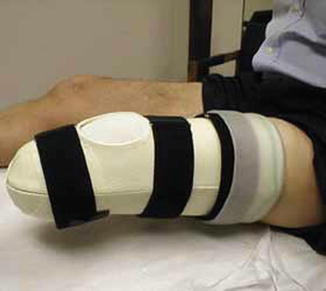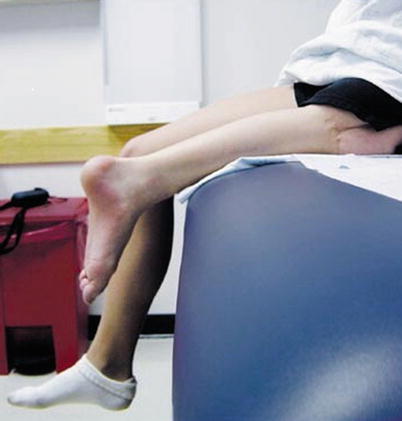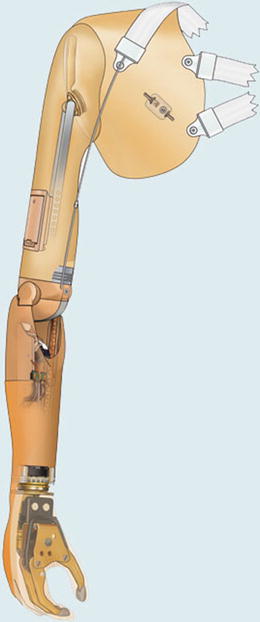Fig. 10.1
Fabric shrinker for a transfemoral amputation. There is a pressure gradient to move the fluid from the distal tip proximally

Fig. 10.2
A removable semi-rigid post-operative dressing. This is placed immediately post-operatively to assist with wound healing, molding of the residual limb, pain, and early mobilization
Preprosthetic training begins as soon as surgical clearance is given and continues until prosthetic fitting is completed. Prosthetic fabrication and fitting ideally should be completed within 4–8 weeks after surgery. Early prosthetic fitting in the upper limb is important, because prosthetic acceptance declines if fitting is delayed beyond the third postoperative month (Fleming et al. 1999). Unfortunately, prosthetic fitting is often delayed in the oncology population due to delayed wound healing secondary to radiation and chemotherapies. So et al. reported a median of 230.5 days until definitive prosthetic fitting in their study of children who had rotationplasty of the knee and required chemotherapy (So et al. 2014). Preprosthetic training helps the child and family transition to prosthetic use and maintains motivation.
Amputation results in a loss of body symmetry, which creates imbalances around the shoulder girdle in transhumeral amputees and around the pelvis with lower limb amputees. Balance in sitting, standing and walking must be relearned. In addition, there may be muscle imbalances around the proximal joint depending on the level of the amputation.
In the upper limb this imbalance results in shoulder elevation and scapula rotation on the affected side. In the lower limb, the anterior superior iliac spine is higher on the affected side and the center of gravity is laterally displaced over the unaffected side. Abnormal and compensatory patterns of movement must be evaluated and adjusted as needed. Patients begin to relearn body position with observing and correcting static postures in the mirror. The amputee is encouraged to use muscle memory to relearn correct postural and limb positioning control (Ganz et al. 2008). As residual limb mobilization progresses, training is focused on recognizing the abnormal postures and positioning that occur with basic ADLs and mobility.
In upper limb amputees, ADLs are mastered with one hand and, when appropriate, with the use of adaptive equipment such as a reacher, sock aide, long handled sponge, and a rocker knife to cut meat. The child progresses from independence with basic hygiene to the advanced ADLs as age appropriate. Hand dominance is retrained when necessary, especially with handwriting and keyboarding. Repetitive tasks can be used for strengthening. These tasks include fine motor exercises with pegs, beads and theraputty, as well as gross motor exercises with equipment and mirrors. Isometric exercises are effective in creating muscle bulk for stabilization of the limb in the socket of the prosthesis if the residual limb is long enough. The stability of the prosthesis depends on both the bulk of the stabilizing musculature and the child’s ability to voluntarily vary residual limb configuration. Because balance is the often disrupted in a new amputee, the goals should include strengthening of the trunk, core, and lower limbs using isometric exercise and aerobic training. For the child with a transhumeral amputation, active assisted range of motion (AAROM) should be done daily at the shoulder. For the child with a transfemoral amputation, maintaining range of motion at the hip is critical and for the child with a transtibial amputation, range of motion must be aggressively pursued at the hip and the knee. The knee is typically kept in full extension except when in therapy. The loss of range of motion and subsequent contracture has significant impact on the fit of the prosthesis and the function of that limb. Bed mobility and getting up from the bed to a chair should begin on post-op day 1. A physical therapist can then begin working on sitting, standing, and ambulation skills. For the lower limb amputee, training is also needed in the use of a wheelchair and any assistive devices such as a walker or crutches. In addition, a tub bench is generally recommended for showering, given the residual balance difficulties and levels of fatigue.
Children with tumor involvement of the knee may decide to undergo rotationplasty in which the tibia with the attached foot and ankle are rotated 180° and attached to the femur (see Fig. 10.3). The ankle then takes on the role of the knee joint. The upper leg initially must be immobilized to allow healing of the osteotomy site. Range of motion at the ankle to increase plantar flexion and muscle re-education of the ankle is started once there is adequate soft tissue healing. To achieve “knee” extension, the child must plantarflex the ankle and to achieve “knee” flexion, the child must dorsiflex the ankle. Full weight-bearing may be initiated once there is complete healing of the osteotomy site. The initial prosthesis often allows room for the foot to extend outside of the socket and bypasses the knee so that knee flexion is not allowed. As the flexibility of the ankle improves, the foot can be contained within the prosthesis (So et al. 2014). Over time, patients can learn these skills quite effectively and even be able to run.


Fig. 10.3
A rotationplasty uses the intact foot and ankle to create a functional knee join
Describing the planned prosthesis, premyoelectric testing and training, and defining the prosthetic expectations of the child and family are all important tasks for the team during the pre-prosthetic period. If a myoelectric prosthesis is being considered, early site testing and training are needed. The residual limb is evaluated by a specially trained occupational therapist for the best sites for placement of the electrodes. The occupational therapist needs to work closely with the physician and prosthetist in the design of the socket and optimal electrode site placement. Motor training is done to increase muscle activity at specific sites using biofeedback. This training may be very difficult in the short trans-humeral amputee due to the paucity of muscle and may change if there is muscle atrophy from radiation therapy. Once isolated movements are mastered, proportional control of the muscle is learned, which controls the speed and force of the prosthetic movements. Advances in prosthetic design have improved hand functionality through myoelectric control with individual actuation of the fingers. In addition, research continues in developing an interface between the brain and the prosthesis which can bypass the need for muscle activation of the electrodes.
The child and family should be taught the names of the prosthetic components in the planned prosthesis.
Teaching includes individual components, such as the figure-of-eight harness, cable, elbow unit or elbow hinge, wrist unit, terminal device, hook or hand, socket, knee unit, and foot. The type of suspension should be reviewed and the indications for socks to improve fit and allow for growth in the socket. Once the prosthesis arrives, these areas should be reviewed as well as the expectations of the child/adolescent with a new limb loss and the family. Often these expectations for function are unrealistic, especially in the upper limb. It is helpful to reinforce the supportive roles the prosthesis will play in cosmesis, gross task and object stabilization, push, and assistive function. A child’s acceptance of the prosthesis is significantly impacted by the family’s opinion of the prosthesis. In addition, care for the residual limb, care for the prosthesis, and potential pitfalls with the prosthesis such as pistoning and misalignment should be reviewed with the child and family.
Each prosthesis is unique and customized to the individual’s needs and body habitus. There are four categories of upper limb prosthetic systems: the passive system, the body-powered system, the externally powered system, and the hybrid system. There are two categories of lower limb prosthetic systems: the passive system and the body-powered system. Each child’s functional goals, extra-curricular activities and lifestyle, geographic location, anticipated environmental exposures, access to prosthetists for maintenance, and financial resources need to be considered in choosing a system. A passive system is primarily cosmetic and often used with forequarter amputees as a stabilizer, for example. A passive system is fabricated for the child who does not have enough strength or movement to control a prosthesis or uses a prosthesis only for cosmesis. A body-powered system prosthesis uses the child’s residual limb strength and range of motion to control the prosthesis. An externally powered system uses an outside power source such as a battery to operate the prosthesis. A hybrid system combines the body-powered system and the externally powered system. An example of a hybrid system is a body-powered elbow joint with an externally powered terminal device (see Fig. 10.4).


Fig. 10.4
An example of a hybrid system is a body-powered elbow joint with an externally powered terminal device
A short transhumeral amputation which occurs proximal to the insertion of the deltoid muscle is a prosthetic challenge. Body-powered control is achieved by scapular motion with assistance from the humerus. In this case, strength and leverage are reduced and cable-powered prosthetic control is severely limited. Up to 5 in. of total excursion of scapular motion is required to open the terminal device with the elbow in the fully flexed position (Bray 1989). A transhumeral prosthesis uses two control cables. One of these cables flexes the elbow and operates the terminal device. The other cable is used to lock and unlock the elbow. Shoulder flexion applies tension to the cable, causing the elbow to flex and the terminal device to open or close depending on how it is set up. To lock the elbow in flexion, the shoulder joint must be extended and abducted at the same time. A “figure-of-eight” body harness can be worn with a transhumeral prosthesis so that the contralateral shoulder can assist to operate the cables and give the child more power and control of the prosthesis.
The cables are eliminated in myoelectric prostheses. They are more comfortable, have a more natural appearance, and provide more precise hand functions with much less effort as compared to body-powered prostheses. However, they tend to be heavier. Suction suspension is possible for the transhumeral level if the residual limb is long enough. The subsequent decrease in harnessing decreases the load on the contralateral axilla. This can reduce the pressure on the contralateral brachial plexus and joints, enhance proprioception, and improve myoelectric contact. Research is now investigating prosthetic implants similar to the dental implants currently in use which would eliminate the need for harnessing and external suspension systems. Suction suspension is usually not possible in residual limbs with recent skin grafts, excessively bulbous distal ends, excessive redundant tissue, or significant adherent distal scarring which is painful.
Lower limb prostheses are not as complex since the fine motor manipulation required of the upper limb is not a factor in the lower limb. However, due to the weight-bearing and constant impact forces through the lower limb, the prosthesis and the joints must be durable, lightweight, and have adequate suspension. Table 10.1 lists some of the prostheses available for the different levels of amputation seen in the population. Functionally, children with a rotationplasty or a transtibial amputation do very well. Energy expenditure to walk the same distance as peers without an amputation increases by only 7 %. This increases to 25 % in the transfemoral group (Waters and Mulroy 1999). With age, the energy expenditure difference will increase between the amputee group and the non-amputee group.
Table 10.1
Prosthetic options for the different levels of amputation
Level of amputation | Prosthesis | Functional capabilities | Other considerations |
|---|---|---|---|
Forequarter | Sculpted insert | None | Provides symmetry at the shoulders to improve fit and drape of clothing |
Forequarter/shoulder disarticulation | Lightweight passive prosthesis | None | Provides balance to the trunk and cosmesis |
Forequarter/shoulder disarticulation | Hybrid forequarter prosthesis | Myoelectrics may control the elbow and/or the hand or a cable system may be used to control the hand (terminal device) | Very heavy and bulky The size of the socket needed for suspension tends to trap heat in the trunk. |
Proximal transhumeral | Myoelectric prosthesis | Myoelectrics give elbow flexion and extension and can power the hand for grip, pronation and supination. Shoulder flexion and extension are often limited by the length of the amputation and if the deltoid is present and usable | Very heavy and bulky |
Proximal transhumeral | Body powered prosthesis | Uses a cable system (often 2 cables) to control the elbow and the terminal device | Lighter than the myoelectrics, but requires good contralateral strength |
Proximal transhumeral | Hybrid prosthesis | Provides battery powered elbow flexion and extension. The individual will open and close the terminal device using contralateral shoulder movements with a cable system | Often combines a myoelectric elbow with and a cable driven terminal device |
Hemipelvectomy | Hemipelvectomy socket with anterior hip joint, knee joint and SACH (solid ankle cushion heel) foot | Provides support for standing, transfers and walking | Alignment must be carefully adjusted to prevent the prosthetic knee from buckling. Prosthetic side should be shorter in length to allow for clearance when swinging the leg in walking |
Transfemoral | Quadrilateral or Ischial containment socket with prosthetic knee and either an energy storing foot or a SACH foot | Can walk independently though speed will be decreased | Energy expenditure may increase from 25–87 % for walking |
Knee disarticulation | Socket with a prosthetic knee and either an energy storing foot or a SACH foot | Walks without difficulty, though cadence may be asymmetric, Walking speed will be slower. | Knee height may be difficult to match due to the size of the prosthetic knee |
Transtibial (below knee) | BKA prosthesis with either an energy storing foot or a SACH foot | Walks without difficulty, but mild increase in energy expenditure of 7 % | Active children tend to prefer the energy storing foot which provides better push off |
10.3.2 Limb Salvage
Limb-sparing procedures have become possible because of advances in imaging, reconstructive surgery, microsurgery, chemotherapy and radiation therapy. As these procedures became more widely utilized by the 1970s, they replaced surgical amputation in preference (Marcove et al. 1970). Upper and lower limb characteristics are different and must be kept in mind when considering the optimal surgical intervention. Since the upper limb is non–weight-bearing and tumors typically present in the proximal humerus for example, distal function can be maintained even with significant sensory impairment following a limb-sparing procedure. Interestingly, the literature does not show a significant difference in quality of life or functional outcomes between limb salvage and ablative surgery groups with malignant bone tumors of the lower limb (Bekkering et al. 2012).
Research has demonstrated that the 70–85 % of malignant tumors treated by limb salvage do not have a significantly different oncologic result (Van Hoesel et al. 2003). The goal is to preserve function, prevent tumor recurrence, improve cosmesis, and enable the rapid administration of chemotherapy or radiation therapy. Initial endoprosthetics replaced the involved bone entirely. Advances in technology now offer expandable and modular options. These are particular helpful in children who are still growing.
The complication rate is much higher after limb salvage than after amputation in the oncology population and must be a factor in their rehabilitation plan. Early complications include infection, wound necrosis, and nerve injury. Late complications include aseptic loosening, prosthetic fracture and dislocation, and graft nonunion (Benevenia et al. 2004).
Stay updated, free articles. Join our Telegram channel

Full access? Get Clinical Tree


